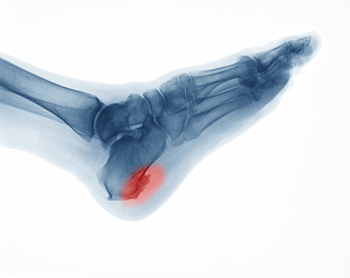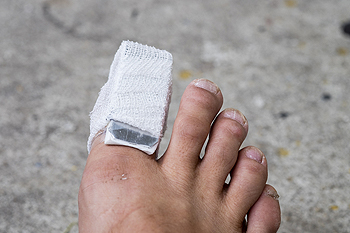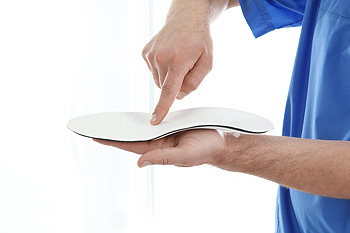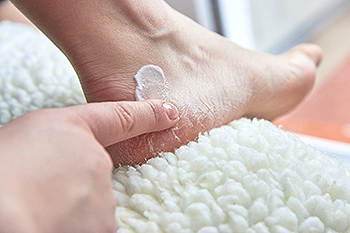Dr. Kennan T. Runte, DPM, FACFAS
Dr. Panah Nabili, DPM
Grass Valley, CA 95945
Dr. Kennan T. Runte, DPM, FACFAS
Dr. Panah Nabili, DPM

Two conditions that involve the growth of bone spurs in the heel are heel spur syndrome and insertional Achilles tendonitis. Calcaneal (heel) spurs commonly develop in people who have plantar fasciitis, an inflammation of the band of tissue that runs along the sole of the foot. Bone spurs sprout as a way of protecting the bottom of the heel. Common causes are strained foot muscles and ligaments, and over-stretching the plantar fascia. Other factors in heel spur development are age, obesity, and osteoarthritis. Fortunately, most heel spurs are not painful. Insertional Achilles tendonitis affects the part of the heel that connects to the leg bone. The spur develops around the tendon and irritates it, causing pain. The inflamed portion of the tendon can then calcify. Insertional Achilles tendonitis usually develops gradually, aided by repetitive running and jumping and the aging process. If you have heel pain, it may be a good idea to consult a podiatrist to conduct an exam and provide treatment based on the diagnosis.
Heel spurs can be incredibly painful and sometimes may make you unable to participate in physical activities. To get medical care for your heel spurs, contact one of our podiatrists from Foothill Podiatry Clinic. Our doctors will do everything possible to treat your condition.
Heels Spurs
Heel spurs are formed by calcium deposits on the back of the foot where the heel is. This can also be caused by small fragments of bone breaking off one section of the foot, attaching onto the back of the foot. Heel spurs can also be bone growth on the back of the foot and may grow in the direction of the arch of the foot.
Older individuals usually suffer from heel spurs and pain sometimes intensifies with age. One of the main condition's spurs are related to is plantar fasciitis.
Pain
The pain associated with spurs is often because of weight placed on the feet. When someone is walking, their entire weight is concentrated on the feet. Bone spurs then have the tendency to affect other bones and tissues around the foot. As the pain continues, the feet will become tender and sensitive over time.
Treatments
There are many ways to treat heel spurs. If one is suffering from heel spurs in conjunction with pain, there are several methods for healing. Medication, surgery, and herbal care are some options.
If you have any questions feel free to contact our office located in Grass Valley, CA . We offer the latest in diagnostic and treatment technology to meet your needs.

Breaking any bone in the body can be a serious threat to your overall health and well-being. Broken toes are no exception. Since the bones in the toes are smaller, they can be particularly vulnerable to being injured and broken. When broken, toe bones will often bleed and swell. It is common also to identify blood beneath the toenail. Breaking bones in the toes is usually extremely painful and can make walking especially difficult. Many patients will wonder how long it takes for a broken toe to heal. Although it varies depending on the patient, the injury, and the particular toe bone, there are several rules of thumb to follow. Broken big toes generally take longer to heal. After wearing a walking boot and then eventually a shoe with a stiff sole, patients can recover from broken big toes in approximately 6 to 8 weeks. Broken toes other than the big toe, commonly the pinky toe, take less time to heal. For example, after strapping and wearing shoes with stiff soles, a patient can recover from a broken pinky toe in 4 to 6 weeks. No patient wants to suffer a broken toe injury for longer than is necessary or to prolong the pain. However, it is important to let the bone take time to properly heal. Always talk with a podiatrist to ask questions about your broken toe bone and how it can be treated.
A broken toe can be very painful and lead to complications if not properly fixed. If you have any concerns about your feet, contact one of our podiatrists from Foothill Podiatry Clinic. Our doctors will treat your foot and ankle needs.
What to Know About a Broken Toe
Although most people try to avoid foot trauma such as banging, stubbing, or dropping heavy objects on their feet, the unfortunate fact is that it is a common occurrence. Given the fact that toes are positioned in front of the feet, they typically sustain the brunt of such trauma. When trauma occurs to a toe, the result can be a painful break (fracture).
Symptoms of a Broken Toe
Generally, it is best to stay off of the injured toe with the affected foot elevated.
Severe toe fractures may be treated with a splint, cast, and in some cases, minor surgery. Due to its position and the pressure it endures with daily activity, future complications can occur if the big toe is not properly treated.
If you have any questions please feel free to contact our office located in Grass Valley, CA . We offer the newest diagnostic and treatment technologies for all your foot and ankle needs.

When visiting a podiatrist, you will be able to consult with medical professionals who can help you create treatment plans for foot afflictions you might have. Depending on your affliction, a podiatrist may recommend the use of orthotics for your feet. Orthotics are specially designed full shoe inserts, heel inserts, and other devices that are meant to provide support or correction to your feet. Unlike inserts that you may be able to purchase at the pharmacy, orthotics are personalized and built to fit your specific foot. Orthotics may be used to rectify deformities in the structure of the foot, support the ankle, or improve foot functioning. These devices have been used to help patients suffering from conditions including arthritis, heel spurs, high arches, plantar fasciitis, bunions, and back pain. Orthotics can be built with rigid materials and significantly flexible substances. While many patients have benefitted from the use of orthotics, success is largely dependent on several factors such as the kind of shoe to which the orthotics are applied as well as the amount of time that the patient actually wears the devices. Each patient is understandably different, and so you might consider consulting with a podiatrist to determine whether or not orthotics could help you address your foot conditions.
If you are having discomfort in your feet and would like to try orthotics, contact one of our podiatrists from Foothill Podiatry Clinic. Our doctors can provide the care you need to keep you pain-free and on your feet.
What Are Orthotics?
Orthotics are inserts you can place into your shoes to help with a variety of foot problems such as flat feet or foot pain. Orthotics provide relief and comfort for minor foot and heel pain but can’t correct serious biomechanical problems in your feet.
Over-the-Counter Inserts
Orthotics come in a wide variety of over-the-counter inserts that are used to treat foot pain, heel pain, and minor problems. For example, arch supports can be inserted into your shoes to help correct overarched or flat feet, while gel insoles are often used because they provide comfort and relief from foot and heel pain by alleviating pressure.
Prescription Orthotics
If over-the-counter inserts don’t work for you or if you have a more severe foot concern, it is possible to have your podiatrist prescribe custom orthotics. These high-quality inserts are designed to treat problems such as abnormal motion, plantar fasciitis, and severe forms of heel pain. They can even be used to help patients suffering from diabetes by treating foot ulcers and painful calluses and are usually molded to your feet individually, which allows them to provide full support and comfort.
If you are experiencing minor to severe foot or heel pain, it’s recommended to speak with your podiatrist about the possibilities of using orthotics. A podiatrist can determine which type of orthotic is right for you and allow you to take the first steps towards being pain-free.
If you have any questions please contact our office located in Grass Valley, CA . We offer the newest diagnostic and treatment technologies for all your foot and ankle needs.

The foot condition known as cracked heels can be unsightly and uncomfortable. In severe cases, it can be difficult to walk and an infection may develop. There are several reasons why this ailment occurs. These can include dehydration from not drinking enough water or from using harsh soaps on the feet. Additionally, there may be existing medical conditions that can cause cracked heels like eczema and psoriasis. Some people may experience this condition from living in extremely cold environments or from using excessively hot water while taking a shower. Mild relief may be found when the feet are washed and dried thoroughly, followed by applying a good moisturizer. It may also help to refrain from wearing shoes that have an open back as well as drink plenty of fresh water daily. Cracked heels can require professional medical attention and it is suggested that you use the services of a podiatrist who can effectively treat this condition.
If the skin on your feet starts to crack, you may want to see a podiatrist to find treatment. If you have any concerns, contact one of our podiatrists from Foothill Podiatry Clinic. Our doctors can provide the care you need to keep you pain-free and on your feet.
Cracked Heels
It is important to moisturize your cracked heels in order to prevent pain, bleeding, and infection. The reason cracked heels form is because the skin on the foot is too dry to support the immense pressure placed on them. When the foot expands, the dry skin on the foot begins to split.
Ways to Help Heal Them
Ways to Prevent Cracked Heels
If you are unsure how to proceed in treating cracked heels, seek guidance from a podiatrist. Your doctor will help you with any questions or information you may need.
If you have any questions, please feel free to contact our office located in Grass Valley, CA . We offer the newest diagnostic and treatment technologies for all your foot care needs.